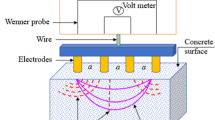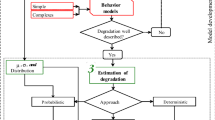Abstract
Chloride-induced reinforcement corrosion is one of the major causes of premature deterioration in reinforced concrete (RC) structures. Given the high maintenance and replacement costs, accurate modeling of RC deterioration is indispensable for ensuring the optimal allocation of limited economic resources. Since corrosion rate is one of the major factors influencing the rate of deterioration, many predictive models exist. However, because the existing models use very different sets of input parameters, the choice of model for RC deterioration is made difficult. Although the factors affecting corrosion rate are frequently reported in the literature, there is no published quantitative study on the sensitivity of predicted corrosion rate to the various input parameters. This paper presents the results of the sensitivity analysis of the input parameters for nine selected corrosion rate prediction models. Three different methods of analysis are used to determine and compare the sensitivity of corrosion rate to various input parameters: (i) univariate regression analysis, (ii) multivariate regression analysis, and (iii) sensitivity index. The results from the analysis have quantitatively verified that the corrosion rate of steel reinforcement bars in RC structures is highly sensitive to corrosion duration time, concrete resistivity, and concrete chloride content. These important findings establish that future empirical models for predicting corrosion rate of RC should carefully consider and incorporate these input parameters.


Similar content being viewed by others
References
S. Ahmad, Reinforcement Corrosion in Concrete Structures, Its Monitoring and Service Life Prediction—A Review, Cem. Concr. Compos., 2003, 25, p 459–471
K. Bhargava, A.K. Ghosh, Y. Mori, and S. Ramanujam, Analytical Model for Time to Cover Cracking in RC Structures Due to Rebar Corrosion, Nucl. Eng. Des., 2006, 236, p 1123–1139
J.P. Broomfield, Corrosion of Steel in Concrete: Understanding, Investigation and Repair, Taylor & Francis, London, 2007
N. Otsuki, M. Madlangbayan, T. Nishida, T. Saito, and M.A. Baccay, Temperature Dependency of Chloride Induced Corrosion in Concrete, J. Adv. Concr. Technol., 2009, 7, p 41–50
M. Raupach, Chloride-Induced Macrocell Corrosion of Steel in concrete—Theoretical Background and Practical Consequences, Constr. Build. Mater., 1996, 10, p 329–338
J. Warkus, M. Raupach, and J. Gulikers, Numerical Modelling of Corrosion—Theoretical Backgrounds, Mater. Corros., 2006, 57, p 614–617
P. Schiel and K. Osterminski, DFG Research Group 537: Modelling of Reinforcement Corrosion—An Overview of the Project, 2nd International Conference on Concrete Repair, Rehabilitation and Retrofitting, Nov 24-26 (Cape Town, South Africa), 2008, p 173–174
M. Raupach, Models for the Propagation Phase of Reinforcement Corrosion—An Overview, Mater. Corros., 2006, 57, p 605–613
J. Gulikers, Theoretical Considerations on the Supposed Linear Relationship Between Concrete Resistivity and Corrosion Rate of Steel Reinforcement, Mater. Corros., 2005, 56, p 393–403
Y. Liu and R.E. Weyers, Modeling the Time-to-Corrosion Cracking in Chloride Contaminated Reinforced Concrete Structures, ACI, Mater. J., 1998, 95, p 675–681
Y. Lu and X. Shi, Stochastic Modeling of Service Life of Concrete Structures in Chloride-Laden Environments, J. Mater. Civ. Eng., 2011, 24, p 381–390
D. Chen and S. Mahadevan, Chloride-Induced Reinforcement Corrosion and Concrete Cracking Simulation, Cem. Concr. Compos., 2008, 30, p 227–238
S.J. Pantazopoulou and K.D. Papoulia, Modeling Cover-Cracking Due to Reinforcement Corrosion in RC Structures, J. Eng. Mech., 2001, 127, p 342–351
O. Burkan Isgor and A.G. Razaqpur,Advanced Modelling of Concrete Deterioration Due to Reinforcement Corrosion, Can. J. Civ. Eng., 2006, 33, p 707–718
B. Martin-Perez, “Service Life Modelling of RC Highway Structures Exposed to Chlorides”, Ph.D. Thesis, University of Toronto, 1998
M.B. Otieno, D. Beushausen, and M.G. Alexander, Modelling Corrosion Propagation in Reinforced Concrete Structures—A Critical Review, Cem. Concr. Compos., 2011, 33, p 240–245
J. Gulikers and M. Raupach, Numerical Models for the Propagation Period of Reinforcement Corrosion, Mater. Corros., 2006, 57, p 618–627
G.K. Glass, L. Page, and N.R. Short, Factors Affecting the Corrosion Rate of Steel in Carbonated Mortars, Corros. Sci., 1991, 32, p 1283–1294
R.R. Hussain and T. Ishida, Enhanced Electro-Chemical Corrosion Model for Reinforced Concrete Under Severe Coupled Action of Chloride and Temperature, Constr. Build. Mater., 2011, 25, p 1305–1315
L. Li and A. Sagues, Metallurgical Effects on Chloride Ion Corrosion Threshold of Steel in Cocnrete, University of South Florida, Florida, 2001
Y. Liu, “Modeling the Time-to-Corrosion Cracking in Chloride Contaminated Reinforced Concrete Structures”, Ph.D. Thesis, Virgina Polytechnic Institute and State University, 1996
W. Lopez and J.A. Gonzalez, Influence of the Degree of Pore Saturation on the Resistivity of Concrete and the Corrosion Rate of Steel Reinforcement, Cem. Concr. Res., 1993, 23, p 368–376
K. Takekawa, T. Yamaguchi, S. Maeda, Simulation Model for Deterioration of Concrete Structures Due to Chloride Attack, J. Adv. Concr.Technol., 2003, 1, p 139–146
D. Trejo, Evaluation of the Critical Chloride Threshold and Corrosion Rate for Different Steel Reinforcement Types, MMFX Steel Corporation of America, Texas, 2002
H. Yalcyn and M. Ergun, The Prediction of Corrosion Rates of Reinforcing Steels in Concrete, Cem. Concr. Res., 1996, 26, p 1593–1599
M. Raupach, J. Warkus, and J. Harnisch, DFG Research Group 537: Modelling of Reinforcement Corrosion—Macrocells and Time Dependence, 2nd International Conference on Concrete Repair, Rehabilitation and Retrofitting, 24-26 November (Cape Town, South Africa), 2008, p 177–178
S. Feliu, J.A. Gonzalez, C. Andrade, and V. Feliu, Determination of the Corrosion Rate of Steel in Concrete by a Non-Stationary Method, Corros. Sci., 1986, 26, p 961–970
T. Maaddawy and K. Soudki, A Model for Prediction of Time from Corrosion Initiation to Corrosion Cracking, Cem. Concr. Compos., 2006, 29, p 168–175
T.J. Kirkpatrick, R.E. Weyers, C.M. Anderson-Cook, and M.M. Sprinkel, Probabilistic Model for the Chloride-Induced Corrosion Service Life of Bridge Decks, Cem. Concr. Res., 2002, 32, p 1943–1960
P. Thoft-Christensen, Stochastic Modelling of the Crack Initiation Time for Reinforced Concrete Structures, Structures Congress 2000: Advanced Technology in Structural Engineering, 8-10 May (Philadelphia, USA), 2004
J. Gulikers, Numerical Modelling of Reinforcement Corrosion in Concrete, Corrosion in Reinforced Concrete Structures, Woodhead Publishing, Cambridge, 2005, p 71–90
B. Huet, V. L’Hostis, G. Santarini, D. Feron, and H. Idrissi, Steel Corrosion in Concrete: Determinist Modeling of Cathode Reaction as a Function of Water Saturation Degree, Corros. Sci., 2007, 49, p 1918–1932
R.E. Melchers, C.Q. Li, and W. Lawanwisut, Modelling Deterioration of Structural Behaviour of Reinforced Concrete Beams Under Saline Environment Corrosion, Mag. Concr. Res., 2006, 58, p 575–587
T. Vidal, A. Castel, and R. Francois, Analyzing Crack Width to Predict Corrosion in Reinforced Concrete, Cem. Concr. Res., 2004, 34, p 165
Y. Zhao, A. Karimi, H. Wong, B. Hu, N. Buenfeld, and W. Jin, Comparison of Uniform and Non-Uniform Corrosion Induced Damage in Reinforced Concrete Based on A Gaussian Description of the Corrosion Layer, Corros. Sci., 2011, 53, p 2803–2814
M. Ohtsu and S. Yosimura, Analysis of Crack Propagation and Crack Initiation Due to Corrosion of Reinforcement, Constr. Build. Mater., 1997, 11, p 437–442
E. Bohner and H.S. Muller, Modelling of Reinforcement Corrosion—Investigations on the Influence of Shrinkage and Creep on the Development of Concrete Cracking in the Early Propagation Stage of Reinforcement Corrosion, Mater. Corros., 2006, 57, p 940–944
S. Guzman, J.C. Galvez, and J.M. Sancho, Cover Cracking of Reinforced Concrete Due to Rebar Corrosion Induced by Chloride Penetration, Cem. Concr. Res., 2011, 41, p 893–902
C. Alonso, C. Andrade, J. Rodriguez, and J.M. Diez, Factors Controlling Cracking of Concrete Affected by Reinforcement Corrosion, Mater. Struct., 1998, 31, p 435–441
Z.-H. Lu, Y.-G. Zhao, and K. Yu, Stochastic Modeling of Corrosion Propagation for Service Life Prediction of Chloride Contaminated RC Structures, 1st International Symposium on Life-Cycle Civil Engineering, 11-14 Jun (Lake Como, Italy), 2008, p 195–201
P.D. Cady and R.E. Weyers, Predicting service life of concrete bridge decks subject to reinforcement corrosion, Symposium on Corrosion Forms and Control for Infrastruture, Nov 3- 4 (San Diego, USA), 1991, p 328-338
L. Chernin, D.V. Val, and K.Y. Volokh, Analytical Modelling of Concrete Cover Cracking Caused by Corrosion of Reinforcement, Mater. Struct., 2010, 43, p 543–556
S. Morinaga, Prediction of Service Lives of Reinforced Concrete Buildings Based on the Corrosion Rate of Reinforcing Steel, Durability of Building Materials and Components,1990, p 5.
W.-Y. Jung, Y.-S. Yoon, and Y.-M. Sohn, Predicting the Remaining Service Life of Land Concrete by Steel Corrosion, Cem. Concr. Res., 2003, 33, p 663–677
K.A.T. Vu and M.G. Stewart, Structural Reliability of Concrete Bridges Including Improved Chloride-Induced Corrosion Models, Struct. Saf., 2000, 22, p 313–333
S.C. Kranc and A.A. Sagues, Detailed Modeling of Corrosion Macrocells on Steel Reinforcing in Concrete, Corros. Sci., 2001, 43, p 1355–1372
M. Klakocar-Ciepacz, P. Falewicz, S. Kuczkowska, and A. Zybura, Modelling of Corrosion of Reinforcement in Contact with Cracked Concrete Cover, Corros. Eng. Sci. Technol., 2011, 46, p 353–359
V. Feliu, J.A. Gonzalez, C. Andrade, and S. Feliu, Equivalent Circuit for Modelling the Steel-Concrete Interface I: Experimental Evidence and Theoretical Predictions, Corros. Sci., 1998, 40, p 975–993
M. Raupach, Preface: Modelling of Reinforcement Corrosion in Concrete, Mater. Corros., 2006, 57, p 603–604
C. Andrade, C. Alonso, and F.J. Molina, Cover Cracking as a Function of Bar Corrosion: Part I—Experimental Test, Mater. Constr., 1993, 26, p 453–464
D. Vorechovska and J. Podrouzek, Modeling of Chloride Concentration Effect on Reinforcement Corrosion, Comput-Aided Civ. Infrastruct. Eng., 2009, 24, p 446–458
M. Pour-Ghaz, O.B. Isgor, and P. Ghods, The Effect of Temperature on the Corrosion of Steel in Concrete. Part 1: Simulated Polarization Resistance Tests and Model Development, Corros. Sci., 2009, 51, p 415–425
J. Rodriguez, L. M. Ortega, J. Casal, and J. M. Diez, Corrosion of Reinforcement and Service Life of Concrete Structures, 7th International Conference on Durability of Building Materials and Components, 19-23 May (Stockholm, Sweden), 1996
S.S. Rasheeduzzafar, S. Al-Saadoun, and A.S. Al-Gahtani, Corrosion Cracking in Relation to Bar Diameter, Cover, and Concrete Quality, J. Mater. Civ. Eng., 1992, 4, p 327–342
J.T. Perez-Quiroz, J. Teran, M.J. Herrera, M. Martinez, and J. Genesca, Assessment of Stainless Steel Reinforcement for Concrete Structures Rehabilitation, J. Constr. Steel. Res., 2008, 64, p 1317–1324
N.A. Al-Abed and H.R. Whitely, Calibration of the Hydrological Simulation Program Fortran (HSPF) Model Using Automatic Calibration and Geographical Information Systems, Hydrol. Process., 2002, 16, p 3169–3188
S. E. Walker, “Modeling Nitrate in Tile-Drained Watersheds of East-Central Illinois”, Ph.D. Thesis, University of Illionois, 1996
M.A. Nearing, L. Deer-Ascough, and J.M. Laflen, Sensitivity Analysis of the WEPP Hillslope Profile Erosion Model, Trans. ASAE, 1990, 33, p 839–849
Acknowledgments
The authors would like to acknowledge the financial support from the Australian Research Council (ARC), Geelong Port, Sydney Ports, and AECOM who co-funded the project as part of Linkage Project LP0883290.
Author information
Authors and Affiliations
Corresponding author
Rights and permissions
About this article
Cite this article
Siamphukdee, K., Collins, F. & Zou, R. Sensitivity Analysis of Corrosion Rate Prediction Models Utilized for Reinforced Concrete Affected by Chloride. J. of Materi Eng and Perform 22, 1530–1540 (2013). https://doi.org/10.1007/s11665-012-0447-1
Received:
Revised:
Published:
Issue Date:
DOI: https://doi.org/10.1007/s11665-012-0447-1




